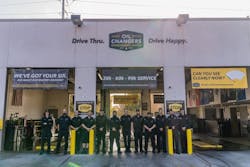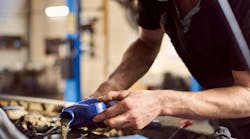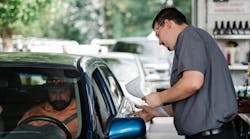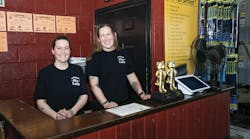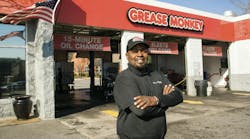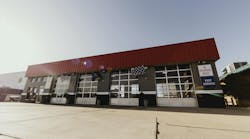To the untrained eye, the building at the corner of West Caldwell Avenue and South Demaree Street in Visalia, California, might look like any other automotive maintenance facility.
To those in the industry, though, this quick lube is something entirely different.
“It’s the Taj Mahal of Oil Changers,” says Justin Shaw, the shop manager.
Opened back in 1999 by Don Nelson as one of four Auto Oil Changers locations in California’s Central Valley, the six-bay behemoth of an oil change shop is a standout in the industry. A sight that Shaw, who was promoted to manager when the shop was acquired by Oil Changers in July 2019, says people need to see in order to appreciate it.
“It’s a true six-bay shop,” he says. “The average shop is two bays, so we’re three shops in one if you really look at it.”
Six-Bay Wonder
The shop’s six bays are laid out in two rows of three, with a two-bay car wash attached on the end of the building.
The shop, which has a workspace about 180 feet long and 40 feet wide and has 32-foot-tall openings on each bay, can accommodate RVs and other diesel operated vehicles. But it’s more geared to standard retail.
In addition to a massive amount of floor space, the shop has 40 oil guns and six oil tanks that have three chambers each, which allows for more flexibility in the number of oils offered and the quantity of each type stored.
“Look at 0W-20 now. That’s the new 10W-30. I’ve already moved the 0W-20 from a 240-gallon tank to a 700-gallon tank just in the three years I’ve been running [the shop],” Shaw says. “That tells you how the industry fluctuates … and we have to be able to adapt.”
All six bays are in operation every day from 8 a.m. to 7 p.m. except for Sundays, when the shop only runs its back three bays. Shaw says the shop will average around 80 cars a day, with an average ticket near $150.
“We’re pretty productive,” he says.
Someone You Trust
Shaw has made a relatively quick ascension to managing his own shop. After spending time as a technician for DirecTV, he made the jump to quick lube in February 2017. What was supposed to be a stop-gap job while he looked for his next role turned into the career he was looking for.
That in large part, Shaw says, is because of the relationships that are built in this industry. Shaw took his customer service experience gained while working on TVs in people’s homes to the shop floor.
“Those are our most intimate spots, our homes and our vehicles,” he says. “You’ve got to have somebody you trust (working on them).”
Starting out at one of the other shop locations, Shaw moved from the pit to the upper bay to assistant manager. After a little over two years, he got his proverbial call from the big leagues and was transferred to the six-bay shop to be the manager during the acquisition by Oil Changers.
“I moved up pretty fast. It’s very fast-paced–it’s all the same, but it’s different every day, you know?” Shaw says. “I've just been trying to improve this shop and make it the best one out there.”
Caring for the Customer
Shaw says the biggest factor in the shop’s success over the last three years has been his crew of 15, who he says could go toe-to-toe with anybody in the business. Building on his experience in the TV cable business, customer service has been a focal point for Oil Changers.
While customer support is nothing new, being able to have the staff to support peak traffic time for a six-bay shop has proven to be a challenge at some points.
“You have to staff the shop enough at all times to where if you fill up all six bays, you don’t have two customers waiting,” Shaw says. “Trying to gauge the public and their needs in a six-bay shop is a challenge, but we’ve got it figured out.”
For any shop, regardless of size, it can sometimes feel like a chicken-or-egg situation when trying to determine if customer volume should dictate staff size or vice versa. Shaw recognizes that it might be a challenge for a shop to justify hiring one or two more techs than is necessary, particularly if a shop is doing well enough, but he says his investment in his staff—both in terms of number of members and how each one is compensated—has played a critical role in his shop’s growth.
“More crew members means more people to pay attention to our guests, because our guests are what keep those six doors open,” he says. “We’ve got to have staff.”
With more people, the shop is able to move at a quicker pace. Shaw says he’s had industry vets come work a day with him at his shop only to be taken aback by how much is going on at one time.
“They come to my shop and they'll work a day with me and they're like, ‘This is crazy,’ … and I'm like ‘Dude, we're only at like 40 cars!” Shaw chuckles. “They tell me it feels like a hundred, and it’s because there’s always something going on. It feels like a good hundred. It’s not a bad thing at all.”
Speed and efficiency are the gold standards in Shaw’s shop, and having the bays set up in a two-by-three grid has allowed techs to operate the shop in a tandem setup. If a vehicle is done and just needs an oil change and one behind it needs a service with pit access, techs can pull the first one through and take care of both simultaneously.
Shaw recommends shops start trying to implement a tandem approach if they have room and capacity to do so. For example, pulling a car forward in a bay and starting an oil change on a half bay.
“The tandem way is the way to go. It just keeps everything flowing. There’s very little idle time in my shop. It’s such a fast shop to be in,” Shaw says. “It’s always moving, and being in a tandem shop, it comes naturally.”
As manager of a six-bay shop, Shaw acknowledges that tactics he might try to increase productivity or efficiency may not directly translate to smaller two- or three-bay shops. However, he says he expects his shop and others around the country to start rebounding from pandemic-era dips in car count, and as such shops need to be ready to handle more vehicles and customers who expect quality and speed.
Maintaining staff levels and ensuring that customers feel welcome and know how long their service might take is crucial in building a strong reputation, which is crucial to good customer reviews. Whether it’s by word of mouth, Yelp, Google or some other platform, having customers talking positively about their experience at your shop will go a long way in building a loyal customer base.
“No (customer) wants to sit out there and not know what’s going on. You have to have enough people to greet someone right as they come onto the property,” he says. “The crew is crucial. Everybody likes being paid attention to, especially if they’re paying money.”
